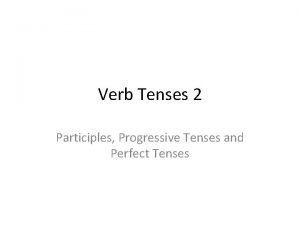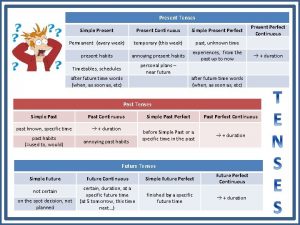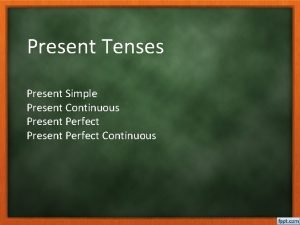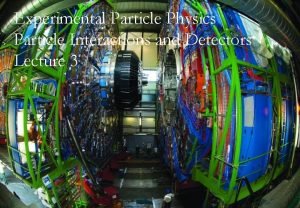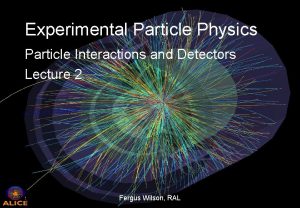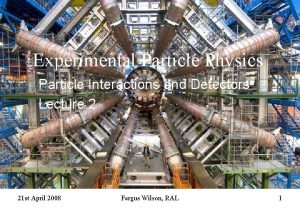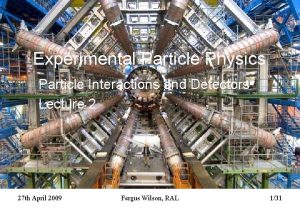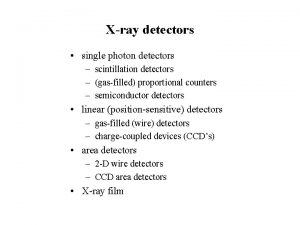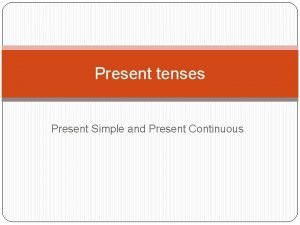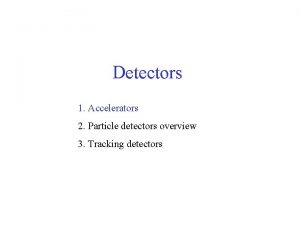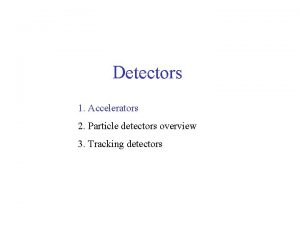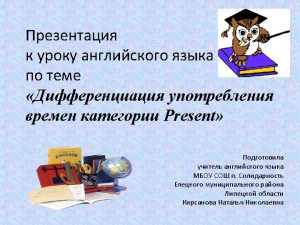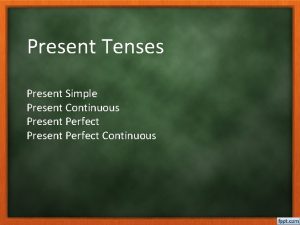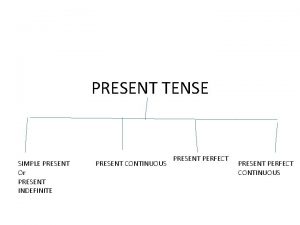experimental methods and detectors for present day particle






































- Slides: 38

experimental methods and detectors for present day particle physics B. Shwartz Budker Institute of Nuclear physics, Novosibirsk 8. 12. 2008 Nagoya University 1

Introduction The development of particle detectors practically starts with the discovery of radioactivity by Henri Becquerel in the year 1896. He noticed that the radiation emanating from uranium salts could blacken photosensitive paper. Almost at the same time X rays, which originated from materials after the bombardment by energetic electrons, were discovered by Wilhelm Conrad R¨ontgen. The scope of the detection techniques in particle detectors is very wide, depending on the aim of the measurement. Each physics phenomenon can be used as the basis for a particle detector. Elementary particles have to be identified with various techniques, and relevant quantities like time, energy, spatial coordinates have to be measured. Particle physics requires extremely high accuracies for these quantities using multi-purpose installations as well as dedicated experimental set-ups. This days particle detectors deal with the particles in an extremely wide energy range - from very low energies (micro-electron volts) to the highest of energies observed in cosmic rays. 8. 12. 2008 Nagoya University 2

Historical remarks Cloud (Wilson) chamber ~ 1911 Bubble chamber ~ 1952, 1953 (D. A. Glaser) Photoemulsion e muon Kaon e+, 63 Me. V Pb, 6 mm 50μ e+, 23 Me. V first positron observation – Anderson, 1932 8. 12. 2008 Nagoya University 3

Typical resolutions and deadtimes of common detectors (PDG) Detector Type Accuracy (rms) Bubble chamber Streamer chamber Proportional chamber Drift chamber Scintillator Emulsion Liquid Argon Drift Gas Micro Strip Resistive Plate chamber Silicon strip Silicon pixel 10– 150 μm 300 μm 50– 300 μmb, c, d 50– 300 μm — 1 μm 175– 450 μm 30– 40 μm 10 μm pitch/(3 to 7)g 2 μmi a Multiple pulsing time. b 300 μm is for 1 mm pitch. c Delay line cathode readout can give ± 150 μm parallel to anode wire. d wirespacing/√ 12. e For two chambers. f n = index of refraction. 8. 12. 2008 Resolution Time Dead Time 1 ms 2μs 2 ns 2 nse 100 ps/nf — 200 ns < 10 ns 1– 2 ns 50 msa 100 ms 200 ns 10 ns — 2 μs — — h h g The highest resolution (“ 7”) is obtained for small-pitch detectors (25 μm) with pulse-height-weighted center finding. July 24, 2008 18: 04 h Limited by the readout electronics [10]. (Time resolution of ≤ 25 ns is planned for the ATLAS SCT. ) i Analog readout of 34 μm pitch, monolithic pixel detectors Nagoya University 4

Main principles: n n ionisation - ~ 90%(? ): charged – initial; neutral secondary cherenkov transition radiation phonons (heat), Cooper pairs, etc. What do we want to know about each particle? a point of origin (vertex) tracking momentum (absolute value and angles) tracking energy calorimetry the particle species particle identification 8. 12. 2008 Nagoya University 5

charged particles momentum mesurement main idea – curvature in the magnetic field main device – drift chambers (however – CMS tracker is fully Si) angles – usually as a component of the momentum measurements chamber precision multiple scattering 8. 12. 2008 Nagoya University 6

Time progection chamber (TPC) • The TPC is a gas-filled cylindrical chamber with one or two endplates • Particle detector invented by D. R. Nygren in 1974 n TPCs have been operated often as the main tracker in a wide range of physics experiments: n particle physics n heavy ion collision n underground experiments • Ingredients: ügas system üfield cage for the E field ümagnet for the B field üamplification system at the anode ügating grid to suppress the ion feedback ülaser calibration system üreadout electronics ütrigger 8. 12. 2008 Nagoya University 7

Characteristics of a TPC STAR ion TPC BNL-RHIC • Track point recorded in 3 -D (2 -D channels in x-y) x (1 -D channel in z = vdrift x tdrift) • Low occupancy large track densities possible • Particle identification by d. E/dx long ionization track, segmented in 100 -200 measurements - LBL STAR TPC - at BNL RHIC ion collider 8. 12. 2008 Nagoya University ALICE simulation events 8

Vertex Detectors • Resolution at IP for two layers with resolution s • r 1/r 2 should be as small as possible • for s=10 mm, r 1/r 2=0. 5, sb = 20 mm • multiple scattering r 2 can’t be large • Beampipe f 5 cm, thickness 1 mm Be = 0. 3% X 0 • 28 mm at IP for P = 1 Ge. V Two conclusions First layer as close as possible to Interaction Point As thin as possible r 1 r 2 Using silicon diode as s detector 1951: first observation of signals in reversely biased p-n junction from a’s Development for tracking stimulated by need to measure short-lived charm/beauty quarks and tau lepton in ’ 70 1980, J. Kemmer: first proposed to use planar process developed in industry to produce strip silicon detectors Fast, localized charge deposition 3 micron intrinsic resolution Planar process dimensions precise to 1 micron, low cost 8. 12. 2008 Nagoya University 9

Strip Detectors n n Depleted p-n diodes Fast and efficient charge collection by drift in electric field n 4 f. C in 300 micron of Si (100 e-h pair per 1 mm of Si) n Each strip has capacitance to backplane and neighbours n Noise is typically dominated by serial contributions scales with detector capacitance 8. 12. 2008 Nagoya University 10

Strips vs Pixels n Strip detectors n Large capacitance, 10 p. F n Large signal, 24000 e n Large noise, 2000 e n n Well established area – dozens of small, large and huge trackers and vertex detectors in operation since ’ 90 New development: strips in depth of sensor – 3 D silicon strips 8. 12. 2008 Pixel detectors n Small capacitance n Extra low noise, 10 -100 e n Could do with small signal Opens variety of interesting options Motivation is to develop new pixel systems in the last years: v. Radiation hardness improvement v. Decrease fabrication cost of pixel detector v. Develop thinner pixel systems v. New interconnect methods (3 D, bonding and vias) v. Easy fabrication of large area devices Nagoya University 11

Linear Collider : Precise Thin Detectors ILC physics demands excellent Vertexing (b, c, t) and Tracking Vertex detector characteristics point resolution 3 mm Thickness ~ 0. 1 % X 0 5 -6 layers Inner radius ~ 1. 5 cm Hybrid pixel detector 3/2 d (IP) < 5 mm t t event 10 mm/(p at 350 sin Ge. V ) (best SLD 8 mm 33 mm/(p sin 3/2 q)) 8. 12. 2008 Nagoya University 12

Active Pixel Sensors – Principle of Operation Simplest design of APS: 3 MOS pixel • Photo diode • Reset MOS (switch) • Select MOS (switch) • Source follower MOS VRST VDD Photo diode Pixel output GND 8. 12. 2008 Functional description n Photo diode: n-well in the p-type epilayer of the silicon n Charge collection: n e-h pairs from ionising radiation n Diffusion of charge in epi-layer n Collected by the diode by the built -in field in the pn-junction n In-pixel circuitry built in p-well. n Collected charge changes the potential on the source follower gate VG = QPD/CPD n Gate voltage changes the transconductance n Pixel selected by the select MOS n Output voltage = VDD-gds*IBias Nagoya University 13

Active Pixel Sensor - Cartoon pixel size 10 -100 μm Photo diode (n-well) n pn-junction with p-epi n 1 -several diodes of varying sizes in different designs. Epi-layer (5 -25 μm) n Active volume of the device n Expected MIP: 400 -2000 ep-well n For in-pixel circuitry In-pixel circuitry n NMOS transistors * Typical values found in different designs 8. 12. 2008 Nagoya University Silicon bulk (10 -700 μm) n Can be thinned as much as mechanical stability allows 14

The HEPAPS 4 – large area sensor for HEP applications Photo diode (n-well) pn-junction with p-epi n n n Epi-layer (5 -25 μm) n Active volume of the device 8. 12. 2008 n Fourth in series designed at RAL Selected most promising design in HEPAPS 2 Basic parameters n 15 x 15 μm 2 pixel size n 384 x 1024 pixels n 20 μm epi-layer n 1 MIP = 1600 e- spread over several pixels Signal – 10 -15 m. V/e; Noise – 40 -45 e Nagoya University 15

Since the momenta of the neutral particle can not be measured directly, we have to determine its total energy and angular coordinates. The most widely used method of the energy measurement is a calorimetric one that means the absorption of the incident particle and the detection of the responce. The main tasks of the calorimeters n n n detection of gamma-quanta and other neutral particles with high efficiency Photon, electron and hadron energy measurements photon coordinates determination electron/hadron separation neutral trigger and total energy trigger signal generation 8. 12. 2008 Nagoya University 16

Calorimetric methods imply total absorption of the particle energy in a bulk of material followed by the measurement of the deposited energy. Let us take as an example a 10 Ge. V muon. Passing through material this particle loses its energy mainly by the ionization of atoms while other contributions are negligible. To absorb all the energy of the muon one needs about 9 m of iron or about 8 m of lead. It is quite a big bulk of material! Main calorimeter principles On the other hand, high energy photons, electrons and hadrons can interact with media producing secondary particles which leads to a shower development. Then the particle energy is deposited in the material much more efficiently. Thus calorimeters are most widely used in high energy physics to detect the electromagnetic and hadronic showers. Accordingly, such detector systems are referred to as ''electromagnetic'' and ''hadron'' calorimeters. 8. 12. 2008 Nagoya University To absorb 95% of the initial energy of the 10 Ge. V photon only about 25 cm of Pb is needed. 17

Homogenious calorimeters - all (almost) material are sensitive. As a read out signal: Scintillation light (crystals, liquid noble gases); Cherenkov light (lead glass calorimeters); Ionization (Lxe, LKr calorimeters) Belle Energy resolution vs energy is approximated as: s 1 - rear leakage s 2 - side leakage, back leakage photoelectron statistics s 3 - electronics noise, dark current noise pile-up noise s 0 - nonuniformity, calibration, rear leakage 8. 12. 2008 Nagoya University 18

Calorimeter angular resolution Photon angles (or coordinates) in the crystal calorimeters are measured usually as corrected center of gravity of the energy deposition: Correction functions (F) can be usually written as a function of one of the angles and energy. meas Before correction However, ionization calorimeters with liquid noble gases provides 10 times better coordinate resolution! true 8. 12. 2008 Nagoya University 19

Sampling calorimeters counter Pb There is a simpler and more economical way to measure the photon energy if the ultimate energy resolution is not crucial. Let us place a thin flat counter behind a thick layer of an absorber corresponding to the depth of the shower maximum. In this naive model the number of electrons crossing the counter is just 2/3 of Nmax = Eg/Ecr, because Nmax is equally shared between electrons, positrons and photons. The amplitude of the counter signal is normally proportional to the number of charged particles. For a lead absorber Ecr = 7. 4 Me. V and Eg = 1 Ge. V, Ne ~ 90. The relative fluctuation of this value is s(Ne)/Ne = 1/ Ne ~ 10%, that provides not so bad an energy resolution! The same idea work for hadrons! 8. 12. 2008 Nagoya University 20

Sampling em calorimeters Signal Ntot = T/d, T – total track length, d – one layer thickness s– thickness of sensitive layer f – sampling fraction 8. 12. 2008 Nagoya University 21

KLOE electromagnetic calorimeter Spaghetti calorimeter 1 mm fiber in Pb, = 5 g/cm 2, X 0 = 1. 6 cm E/E = 5. 7%/ E(Ge. V); t = 50 ps/ E(Ge. V). 8. 12. 2008 Nagoya University 22

High Resolution SHASHLIK (KOPIO) 300 x Pb: Sc = 0. 275 : 1. 5 mm σE /E=2. 8%/√E 1. 3% 35 Me. V/E Layers Fibers Effective X 0 Moliere radius Active depth Weight 300, 360 72 x 1. 5 m = 108 m 34. 9 mm 59. 8 mm 555 mm (15. 9 X 0) 21 kg/module PANDA NIM A 584(2008)291, G. S. Atoian et al. 8. 12. 2008 Nagoya University 04. 03. 2008 Rustem Dzhelyadin(IHEP, INSTR 08 Conference, BNPI, Novosibirsk, Russia Protvino) 23

Hadron calorimeters <p. T> 0. 35 Ge. V/c, average inelasticity 50% Typical energy resolution – σE/E ~ (50 -70)%/√E(Ge. V) Esh = E 0 (f. EM + fion + finv), where f. EM - energy of e-m showers initiated by secondary neutral pions; fion – ionization losses of charged particles; finv – invisible energy (binding energy, slow recoiles and neutrino) 8. 12. 2008 Nagoya University 24

Monte-Carlo study of Hadronic Cascade Dual readout calorimeters How alternative measurement of em component can improve the resolution? Q = quartz sensitive to em S = scintillating light R=(1 -h/e)Q / (1 -h/e)S Ecorr = (RS-Q)/(R-1) 8. 12. 2008 Nagoya University 04. 03. 2008 Rustem Dzhelyadin(IHEP, INSTR 08 Conference, BNPI, Novosibirsk, Russia Protvino) 25

Dual Readout Calorimeter (DREAM) DREAM prototype test-beam 8. 12. 2008 Nagoya University 04. 03. 2008 Rustem Dzhelyadin(IHEP, INSTR 08 Conference, BNPI, Novosibirsk, Russia Protvino) 26

Particle identification n electrons vs muons, hadrons – showers in the EM cal. muons vs hadrons – ionisation range common for the charged particles: v ionization v particle velocity – ionization v cherenkov radiation v transition radiation Time-of-flight: New ingredients: Faster photon detectors (working PMT) Use of Cherenkov light instead of scintillation photons Faster electronics ALEPH TPC – 0. 6 truncated mean method Recent results: resolution ~5 ps measured K. Inami NIMA 560 (2006) 303 neutral particles identification – specific for each exp. 8. 12. 2008 Nagoya University 27

Cherenkov radiation A charged track with velocity v=bc exceeding the speed of light c/n in a medium with refractive index n emits polarized light at a characteristic (Čerenkov) angle, cos = c/nv = 1/bn Two cases: b < bt = 1/n: below threshold no Cherenkov light is emitted. b > bt : the number of Cherenkov photons emitted over unit photon energy E=hn in a radiator of length L: Few detected photons 8. 12. 2008 Nagoya University 28

Examples of Cherenkov rings – SNO experiment – 1000 ton heavy water viewed by 10000 PMT n m + N m- + X 0. 9 ms later SNO experiment m e + nm + ne 8. 12. 2008 Nagoya University 29

The Compact Muon Solenoid detector (CMS) is a general purpose detector with a large superconducting solenoid 22 m 8. 12. 2008 Nagoya University 30

Cryogenic detectors The main idea to use the quantum transition requiring lower energy than that for ionization. 1. Phonons - 10 -5 e. V 2. Cooper pairs – 4 10 -5 - 3 10 -3 e. V + Low temperature → low noise These detectors are developed for already more than 20 years. Now variety of detectors exist – from 1 g (microcalorimeters) to 10 th of kilograms (macrocalorimeters) of working wolume. 8. 12. 2008 Nagoya University compare: scintillator – 100 e. V/ph germanium – 3 e. V/ e-h pair T = E/C 31

8. 12. 2008 Nagoya University 32

Эксперимент CDMS Cryogenic Dark Matter Search (USA) Detection with low-temperature bolometers Thermistor (NTD Ge) Heat signal (phonons) Electrodes (charge collection) Ge T~20 m. K Ionisation signal 8. 12. 2008 Nagoya University At the low temperature, the specific heat capacity becomes very small. According to the Debye model: D=1944 J/mol/K, T –temperature (K), D–Debye temperature. For Ge, D = 374 K. At T ~ 20 м. К CGe ~ 1 ke. V/mol/μK. 33

Эксперимент CDMS The detectors are assembled into “towers”. One tower has 7 detectors. The towers are inserted into the “icebox”, which is really much colder than ice! In fact, the detectors work best at only 0. 05 degrees Celsius above absolute zero, the temperature where all random thermal motion stops. 4. 75 kg Ge, 1. 1 kg Si Calibration by γ, n γ n 0 events 8. 12. 2008 Nagoya University 34

electical signals to particle parameters trigger provides signal to start the data acquisition: background suppression down to the acceptable level while to keep signal efficiency close to 100%. Modern option – pipe line readout raw data consist of the “events” which contain: Ni – number of hit channel; i = 1, …. M, where M – number of hits in the event; Ai – amplitude (charge) of the signal of this cjannel; 8. 12. 2008 ti – time of signal occurrence. Nagoya University 35

Data processing Ei = ai∙(Ai-Pi) Ti = bi∙(ti-ti 0) ai, bi - calibration coefficients Pi, ti 0 - pedestals How to learn the calibration coefficients? Calorimeter (for example): Cosmic rays give Ci without beam (initial input). Ci absolute calibration; Bhabha, e+e−→gg by minimizing “photon” = “cluster” but not “track” Vk = V(“track 1”, … “track. Lk”) (θk, k) = F(“track”k) Ephk = (E 1+E 2+ … + Eck)·f(Et, θ, ) Lk = ID(track, cluster, id-spec) 8. 12. 2008 Nagoya University minimal kit for further analysis 36

Results evaluation ε - efficiency of the detector; L – luminosity of the accelerator e. MC – efficiency, obtained by the MC simulation; dexp – correction found from the experimental data; dtrig – correction for trigger inefficiency; d. E – correction for the energy spread or energy resolution; drad – radiative corrections Finally: = exp ± dstat ± dsyst. ± [dmod] 8. 12. 2008 Nagoya University 37

Conclusion Measure what is measurable, and make measurable what is not so. Galileo Galilei The scope of detection techniques is very wide and diverse. Depending on the aim of the measurement, different physics effects are used. Basically, each physics phenomenon can be the basis for a particle detector. If complex experimental problems are to be solved, it is desirable to develop a multipurpose detector which allows one to unify a large variety of different measurement techniques. This would include a high (possibly 100%) efficiency, excellent time, spatial and energy resolution with particle identification. For certain energies these requirements can be fulfilled, e. g. with suitably instrumented calorimeters. Calorimetric detectors for the multi-Ge. V and for the e. V range, however, have to be basically different. The discovery of new physics phenomena allows one to develop new detector concepts and to investigate difficult physics problems. For example, superconductivity provides a means to measure extremely small energy depositions with high resolution. The improvement of such measurement techniques, e. g. for the discovery and detection of Weakly Interacting Massive Particles (WIMPs), predicted by supersymmetry or cosmological neutrinos, would be of large astrophysical and cosmological interest. 8. 12. 2008 Nagoya University 38
 Day 1 day 2 day 3 day 4
Day 1 day 2 day 3 day 4 Experimental vs non experimental
Experimental vs non experimental Descriptive vs correlational vs experimental research
Descriptive vs correlational vs experimental research Disadvantages of experimental research
Disadvantages of experimental research Experimental vs nonexperimental research
Experimental vs nonexperimental research Nonexperimental study
Nonexperimental study Day 1 day 2 day 817
Day 1 day 2 day 817 Where are feature detectors located
Where are feature detectors located Feature detectors ap psychology
Feature detectors ap psychology Rhmd: evasion-resilient hardware malware detectors
Rhmd: evasion-resilient hardware malware detectors Feature detectors
Feature detectors Frontier detectors for frontier physics
Frontier detectors for frontier physics Diagnosing error in object detectors
Diagnosing error in object detectors What is thermal detector
What is thermal detector What is streaming potential
What is streaming potential Vhv voltage detectors
Vhv voltage detectors Photo detectors
Photo detectors Nuclear detectors
Nuclear detectors Hplc detector types
Hplc detector types Giant wave detectors murmurs universe
Giant wave detectors murmurs universe Gravitational wave hear murmurs universe
Gravitational wave hear murmurs universe Fabrication of wax pattern
Fabrication of wax pattern Present simple present continuous and present perfect
Present simple present continuous and present perfect Romeo and juliet timeline of events
Romeo and juliet timeline of events Present perfect present simple present continuous
Present perfect present simple present continuous Present perfect simple vs present perfect continuous
Present perfect simple vs present perfect continuous Present continuous schema
Present continuous schema Simple present present perfect present progressive noredink
Simple present present perfect present progressive noredink Present perfect continuous passive
Present perfect continuous passive Present simple present continuous present perfect
Present simple present continuous present perfect Kontinuitetshantering
Kontinuitetshantering Typiska novell drag
Typiska novell drag Nationell inriktning för artificiell intelligens
Nationell inriktning för artificiell intelligens Ekologiskt fotavtryck
Ekologiskt fotavtryck Varför kallas perioden 1918-1939 för mellankrigstiden
Varför kallas perioden 1918-1939 för mellankrigstiden En lathund för arbete med kontinuitetshantering
En lathund för arbete med kontinuitetshantering Adressändring ideell förening
Adressändring ideell förening Personlig tidbok för yrkesförare
Personlig tidbok för yrkesförare Anatomi organ reproduksi
Anatomi organ reproduksi



























